Note: this post is a *little* too long for email. If you’re reading this as an email, click the title to read the whole thing on Substack!
Here’s something I’m incredibly grateful for: John re-learning to play the guitar in 2015.
I was pregnant with our first daughter, he hadn’t picked up a guitar since middle school, but of his own accord he decided that he wanted music to be a part of our family life and so he tooled around YouTube and was playing all of our favorite songs in weeks. (Which, truly, boggles my mind. It would have taken me years to do the same.)
Fast forward a few months, and there was only one downside to our frequent family singalongs: a bulky black guitar case had taken up permanent residence in our family room — which was not exactly my idea of a good time, interior-decorating-wise.
I was itching to ditch it, but was wary of falling into a trap Shawn Achor describes in his book The Happiness Advantage:
“Had the path of least resistance led me astray? I thought back to that initial experiment. I had kept my guitar tucked away in the closet, out of sight and out of reach. It wasn’t far out of the way, of course, but just those 20 seconds of extra effort it took to walk to the closet and pull out the guitar had proved to be a major deterrent. I had tried to overcome this barrier with willpower, but after only four days, my reserves were completely dried up. If I couldn’t use self-control to ingrain the habit, at least not for an extended period, I now wondered: What if I could eliminate the amount of activation energy (the time, choices, and mental and physical effort) it took to get started?
I took the guitar out of the closet, bought a $2 guitar stand, and set it up in the middle of my living room. Nothing had changed except that now instead of being 20 seconds away, the guitar was in immediate reach. Three weeks later, I looked up at a habit grid with 21 proud check marks.
What I had done here, essentially, was put the desired behavior on the path of least resistance, so it actually took less energy and effort to pick up and practice the guitar than to avoid it. The strategy is universally applicable: Lower the activation energy for habits you want to adopt, and raise it for habits you want to avoid.”
We had gotten into such a good rhythm of family singalongs, and I didn’t want to derail us by storing the guitar out of sight and out of mind. But I wanted it off my floor. So after some thought and Googling, I bought a guitar hook and we hung John’s beauty right behind our sofa. Problem solved! The guitar was still easily accessible, we no longer had a big case taking up floor space, and we gained some fun new wall decor, to boot.
While Shawn’s observation likely piqued my interest because of my similar guitar quandary, the idea of shaping your environment to prioritize choices that are valuable to you applies to more than just guitar playing. The idea has resurfaced for me many times since, in books like The Tech-Wise Family and the blockbuster Atomic Habits. But the first to popularize the idea were the Nobel Prize winner Richard Thaler and Cass Sunstein in their book Nudge, which Andy Crouch references in The Tech-Wise Family:
“Nudges are small changes in the environments around us that make it easier for us to make the choices we want to make or want others to make. Nudges don’t generally make us do anything, but they make certain choices easier and more likely. They don’t focus so much on changing anything about our own preferences and ability to choose well; they simply put the best choice right in front of us and make the wrong choice harder.”
It’s no exaggeration to say I’ve thought about this idea monthly, if not weekly, since hearing about it — going on ten years now! It’s affected countless decisions in our home for all sorts of things, but particularly in pursuit of low-screen living. Our children will find themselves in plenty of environments that are optimized for technology in their daily lives, but we want our home to be something different — a place that’s a soft landing place for the tactile, the creative, the real, and the true.
Little by little, small choices have made a difference. They’ve shaped our home into that soft place, and I wanted to share a few today. While you might not make the exact same choices as we have, I hope they get your wheels turning for choices that might be a good fit for your unique family!
A smaller television | Our TV measures 32”. While a step up from the original tube TV that graced our first apartment, and originally chosen more for budget reasons than tech ones, our smaller TV underscores the place we want shows and movies to have in our family life: present, but not the most important thing in the room.
I know some families choose to move their TV out of the main family room altogether, which I think can also be a great choice.
A piano keyboard in the main room | While a large black keyboard on a metal stand would, again, not be my first choice for decor in our main room, I consider it a sacrifice in the name of something that is important to me — our children learning to create music rather than simply consume it.
A pride-of-place for the Nugget | A Nugget play couch was our kids’ big Christmas present last year, and there’s no obvious place to store it — so, out in the open it stays! Perhaps because of this, it is played with daily, along with the large basket of blankets right beside. It’s been used to make forts, forts, and more forts, plus trampolines, obstacle courses, the Hogwarts Express, and more.
Books in the main room | A tall bookshelf is one of the first places your eye lands when you walk in our front door. Not only does it put some of our favorite books right at our fingertips, but it’s a physical representation of the central role reading and stories play in our family.
Kid books right in the middle of things | Similarly, we keep a rotating collection of favorite picture and board books right at kid height in our family room. It’s easy for the kids to flip through a stack of their favorites solo or request a read-aloud, both of which they do frequently.
Books on my bedside table | Low-screen living cues are for grown-ups, too! Keeping my current read close at hand (and the next handful on my TBR list) means I’m always eager to hop into bed, no phone in sight.
Games on the coffee table | We don’t only read around here :) Moving some of our favorite open-and-go games within arm’s reach (instead of tucked inside the chest) has made us much more likely to play a quick round after school.
Crossword puzzle book next to chair | Leaving a puzzle book within arm’s reach gives John or me an easy phone-free activity to reach for when the kids are playing independently and we want to be nearby but let them do their own thing.
Conversation cards on table | Keeping our conversation cards and current family read-aloud right on the table makes it easy to reach for them at dinner and breakfast, respectively. Might they get greasy fingerprints or tomato sauce splatters on them? Yes. (But worth it.)
Cozy blankets | A pile of soft blankets just beckons kids to cuddle up and stay awhile. And here’s where even subtle cues make a big difference: if this basket was filled with neatly folded squares, it’s possible it would seem less approachable, and our kids would be less likely to reach for it. A messy pile is an invitation. (Of course, I’m not always against neatness or folding blankets — just something to think about!)
Guitar on the wall + instruments in a basket | And here it is — the original inspiration! In the years since hanging John’s guitar on the wall, we’ve added two more kids to our family band and several more instruments. Instead of mixing them in with the other toys, we keep them together in a basket — which makes it easy to bring them downstairs and add to the joyful noise.
It’s easy to think that tucking something in a drawer, or putting it in a closet, won’t make much of a difference in how often we use it. But small changes can have big impacts on our habits and behaviors. And over time, these small changes (which often cost $0 and just a little thoughtful curiosity!) move you in a direction. The key is making sure it’s the direction you want to go. For us, lowering the activation energy and adding (or subtracting!) environmental cues has added up to a home that meets us in our pursuit of low-screen living, daily helping us to be more present, creative, thoughtful, and yes, connected. I’ll take that over neatly-folded blankets or a clear coffee table any day :)
I’d love to hear: have you tweaked something in your home that had a big impact on how you lived in it? Any low-screen living cues to share with the group? Please come tell us!
Would you consider sharing this newsletter?
Almost 100% of my newsletter growth comes from recommendations from readers. Chances are that if you made it this far, you care about kids and technology and know others who would enjoy The Connected Family. Taking just a few moments to forward to a friend or share on Instagram/Notes/your mom-friends text chain can make a huge difference. Thank you! ❤️





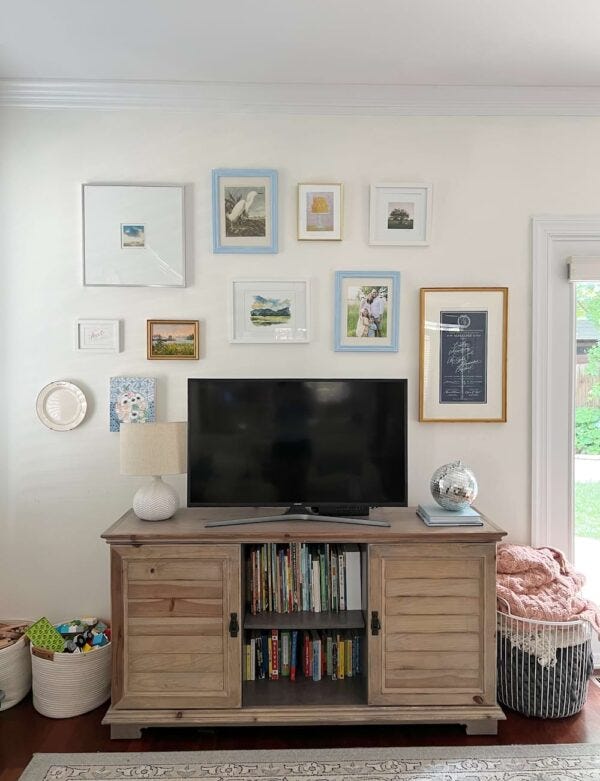



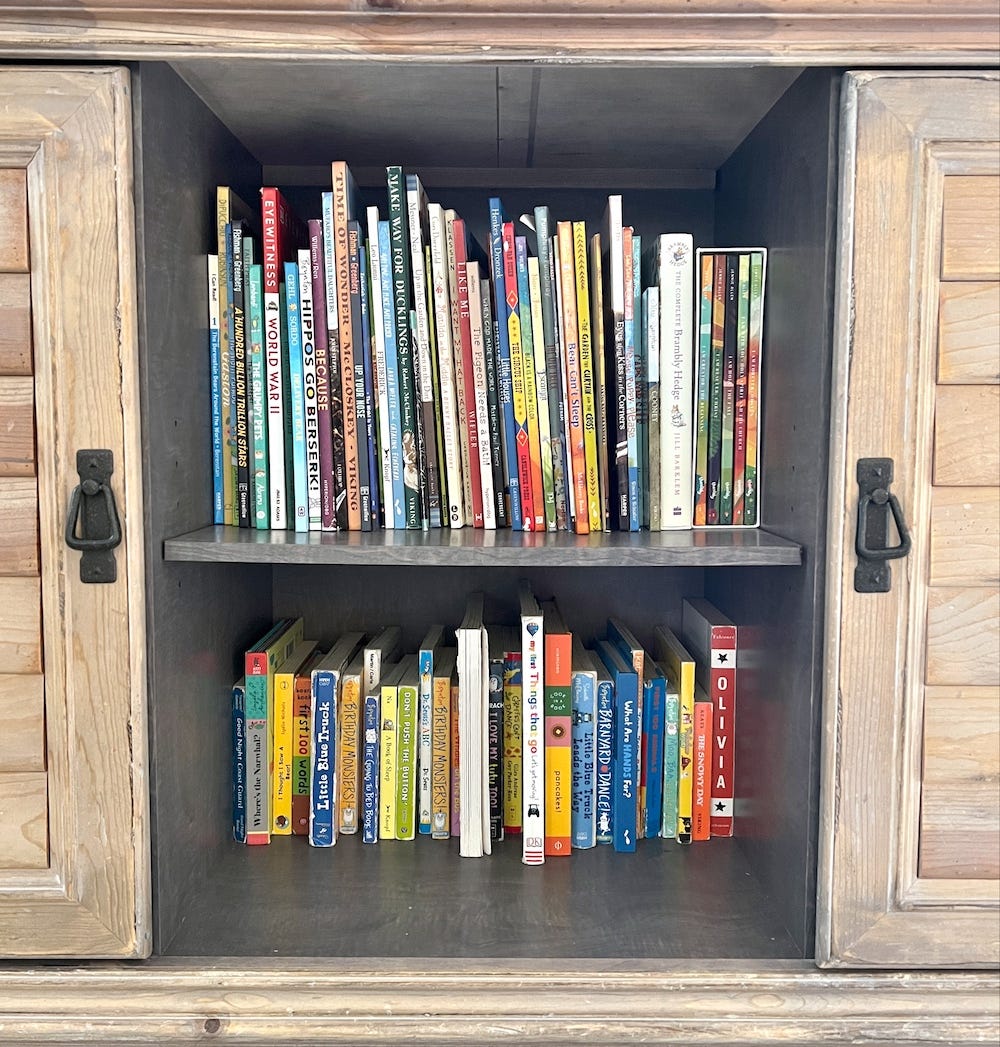

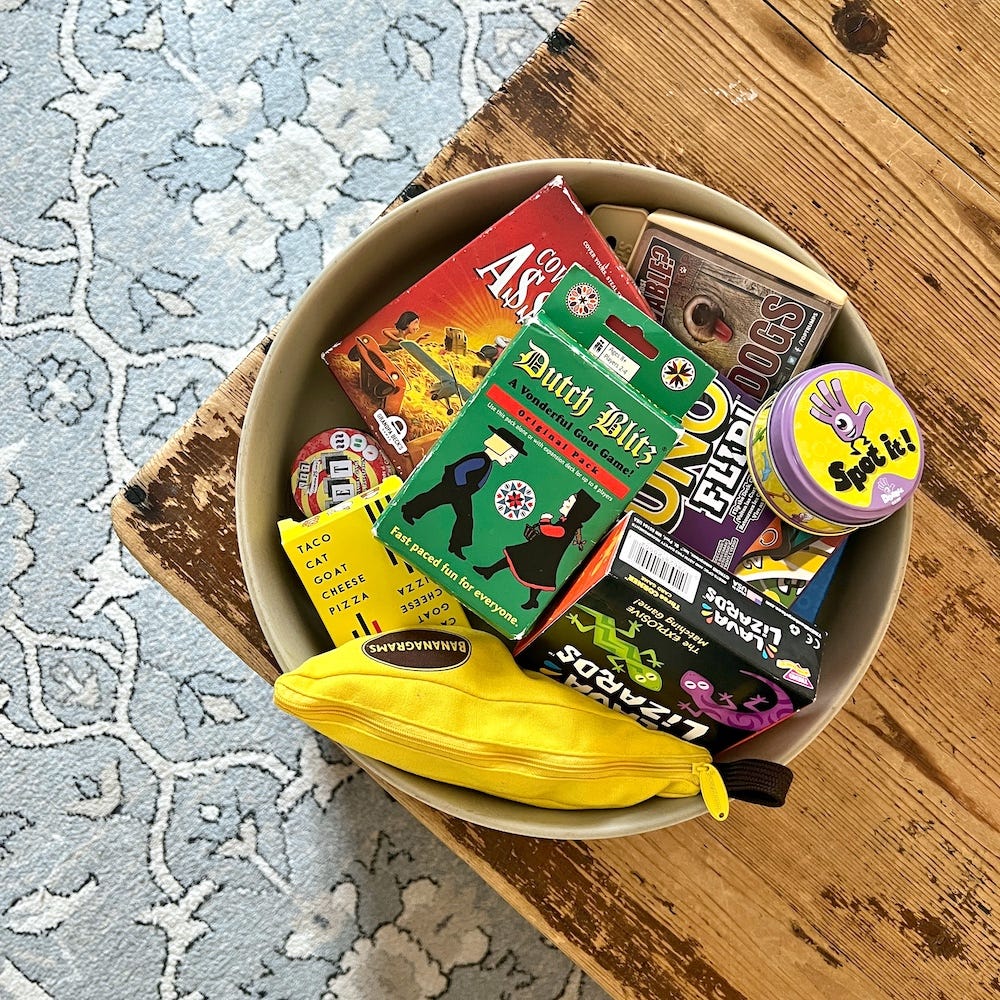


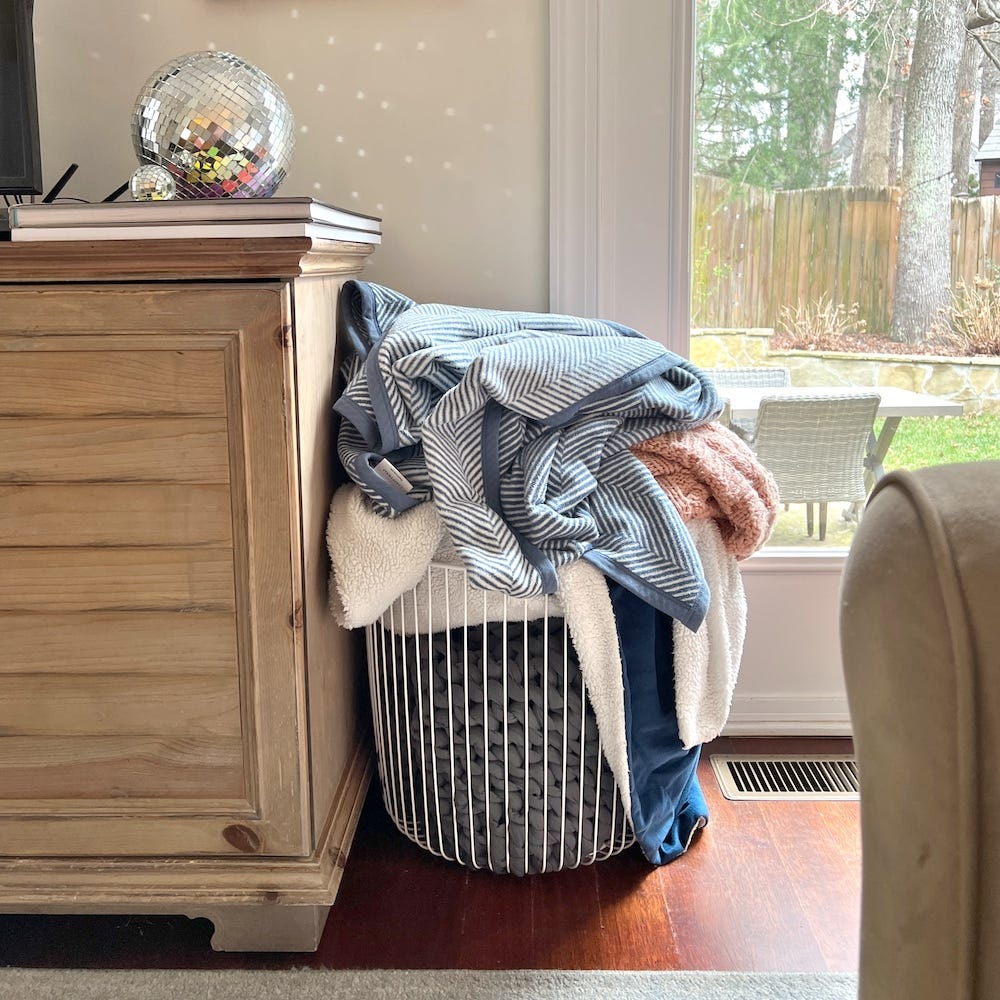
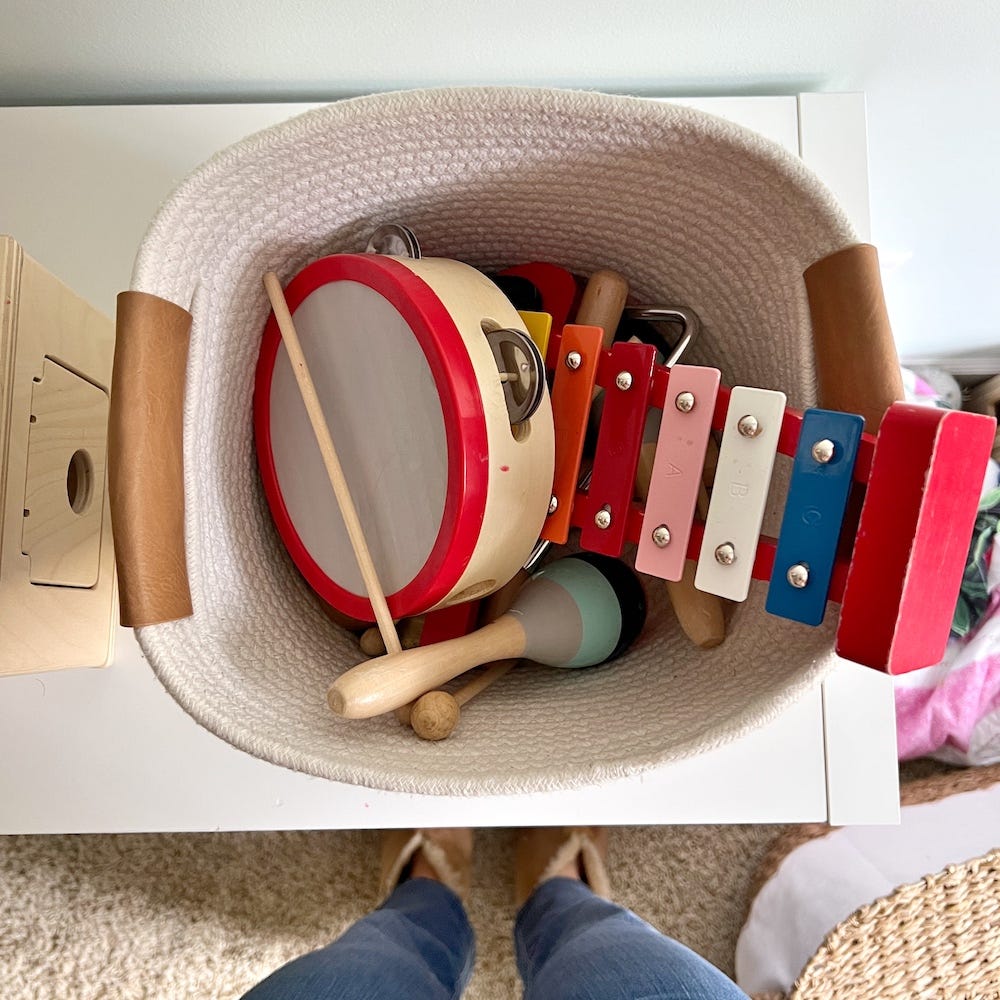
Love this! We have a lot of similar set ups at our house, too. Our old tv was a hand-me-down from Omar’s parents, and was pretty big. We that kicked the bucket, we opted for a much smaller Samsung Frame TV. These are not cheap, but you can mount them and it looks like art. We got new living room furniture this past year and were finally able to mount the TV and I love it. I love that it displays art(and I love the art it displays! I look at the painting we chose all the time), and I have had multiple people turn to me a couple of hours after being over and say “wait - is that a TV? I never would have guessed” - so a win/win there :)
No TV is a game changer, which we’ve done for over a decade now. We watch stuff on the ipad in bed or on the computer in the kitchen; certainly less appealing. For sporting events it encourages us to go out to a bar with the whole family, which can be really fun.
Great games we keep on the kitchen table along with the conversation cards are the Animal Balance game (Amazon) the cracker barrel triangle peg thingy, and the Top Trumps “Deadliest Predators” cards (an Em for Marvelous stocking stuffer rec!) I notice even our adult friends taking an interest in these games whenever we’re hanging out in the kitchen.